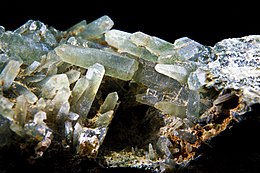Prasiolite
| Prasiolite | |
|---|---|
 | |
| General | |
| Category | Oxide mineral |
| Crystal system | Trigonal |
| Identification | |
| Color | shades of green |
| Crystal habit | Hexagonal prisms |
| Cleavage | None |
| Fracture | Conchoidal[1] |
| Tenacity | brittle[1] |
| Mohs scale hardness | 7 – lower in impure varieties[1] |
| Diaphaneity | Transparent to nearly opaque |
| Specific gravity | 2.65 |
| Refractive index | 1.544 to 1.553[2] |
| Birefringence | 0.009[3] |
| Ultraviolet fluorescence | none |
Prasiolite (also known as green quartz, green amethyst or vermarine) is a green variety of quartz, a silicate mineral chemically silicon dioxide.
Since 1950, almost all natural prasiolite has come from a small Brazilian mine, but it has also been mined in Lower Silesia in Poland. Naturally occurring prasiolite has also been found in the Thunder Bay area of Canada.[4] As of February 2019[update], the only mine producing prasiolite is in Brazil but even that is almost mined out.
Most prasiolite sold is used in jewellery settings, where it can substitute for far more expensive precious gemstones.
It is a rare stone in nature; artificially produced prasiolite is heat treated amethyst.[4] Most amethyst will turn yellow or orange when heated producing citrine, but some amethyst will turn green when treated. Currently, almost all prasiolite on the market results from a combination of heat treatment and ionizing radiation.[5]
Green quartz is sometimes incorrectly called green amethyst, which is not an acceptable name for the material, the proper terminology being prasiolite.[6] It is against Federal Trade Commission Guidelines to call prasiolite "green amethyst". Other names for green quartz are vermarine, greened amethyst, or lime citrine.
The word prasiolite literally means "scallion green-colored stone" and is derived from Greek πράσον prason meaning "leek" and λίθος lithos meaning "stone". The mineral was given its name due to its green-colored appearance.
Natural prasiolite is a very light, translucent green. Darker green quartz is generally the result of artificial treatment.[7]
See also
References
- ^ a b c "Prasiolite gemstone information". www.gemdat.org. Retrieved 19 April 2018.
- ^ Lazarelli. Blue Chart Gem Identification. p. 7.
- ^ "PRASIOLITE the green variety of quartz (aka Green Amethyst)". www.galleries.com. Retrieved 19 April 2018.
- ^ a b "Prasiolite". quarzpage.de. 28 October 2009. Retrieved 28 November 2010.
- ^ "Mineral Spectroscopy Server". California Institute of Technology. 11 June 2012. Retrieved 10 December 2012.
- ^ "Green Amethyst". GemSelect. Retrieved 10 December 2012.
- ^ Gems and Gemstones: Timeless Natural Beauty of the Mineral World By Lance Grande, Allison Augustyn, p.91
External links
